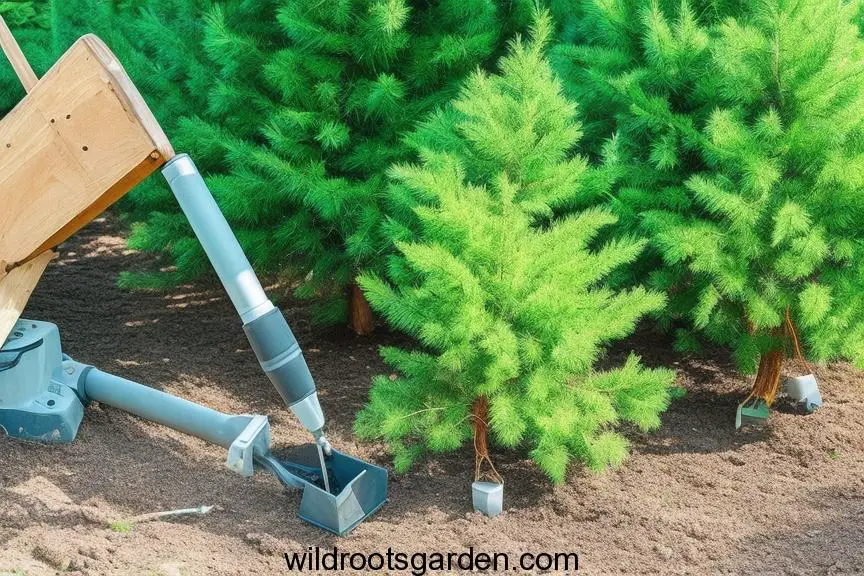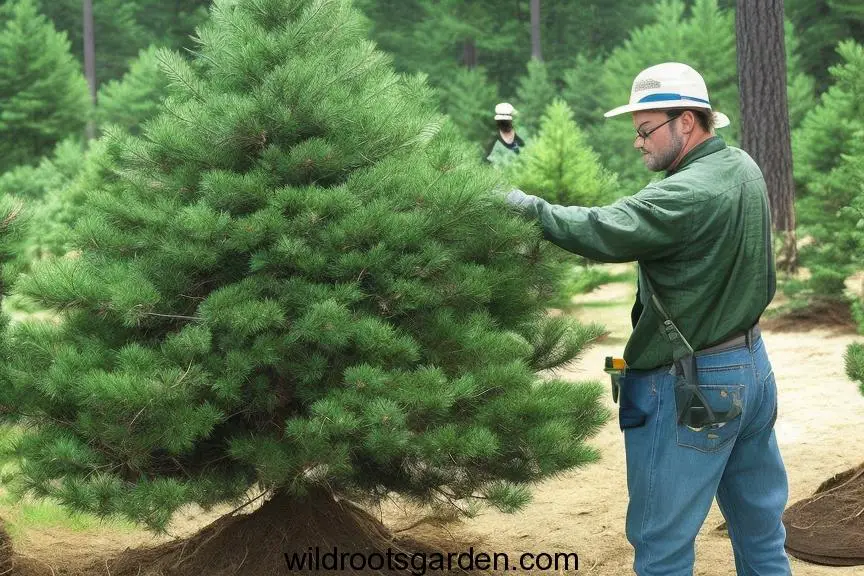Guide to Transplanting Pine Trees Pine trees, with their majestic beauty, can be a wonderful addition to your backyard landscape. While many pine trees are grown from seeds, you can also successfully transplant them. Proper technique and care are crucial for ensuring the success of the transplant. Whether you’re moving trees from the wild or from a nursery, following a well-thought-out plan is essential.
JUMP TO TOPIC
- 1 Necessary Tools for Successfully Transplanting Pine Trees:
- 2 Embarking on Your Pine Tree Transplanting Journey:
- 3 Ideal Times for Transplanting Pine Trees: A Closer Look
- 4 The Significance of Timing in Pine Tree Transplantation
- 5 Transplanting a Six-Foot Pine Tree: Special Considerations
- 6 Pine Tree Transplanting Insights
- 7 Frequently Asked Questions
Necessary Tools for Successfully Transplanting Pine Trees:

- Small Garden Shovel (for Initial Preparation): This versatile tool is your first step in preparing the tree for transplantation. It helps you create the right environment by loosening the soil around the tree.
- Large Shovel (for Digging and Transplantation): The backbone of your transplanting endeavor, a large shovel allows you to dig a spacious hole to accommodate the tree’s root system. It’s essential for a successful and smooth relocation.
- Watering Can (to Keep the Roots Hydrated): Proper hydration is crucial during and after transplantation. Watering can ensure that the delicate root system receives the moisture it needs to establish itself in its new home.
- Old Towels or Tarps (for Root Protection): The roots of a pine tree are delicate and sensitive. Using old towels or tarps to gently wrap and protect the roots during transportation minimizes stress and potential damage.
- Pine Mulch (to Aid in Retaining Moisture Post-Transplant): Mulch is like a protective blanket for the soil around the transplanted tree. Pine mulch is particularly beneficial, as it not only helps retain moisture but also provides nutrients as it breaks down.
- Evergreen Knowledge and Enthusiasm!: Your expertise and excitement about the process are essential components. Understanding the specific needs of pine trees and approaching the task with enthusiasm contribute to a successful transplant.
- Gloves and Safety Gear (for Personal Protection): Don’t forget to safeguard yourself. Gloves and appropriate safety gear ensure you’re comfortable and protected while working with tools and soil.
- Biodegradable Burlap (for Wrapping the Root Ball): When dealing with larger trees, using biodegradable burlap to wrap the root ball provides an extra layer of protection and aids in maintaining moisture levels.
- Stakes and Twine (for Stabilization): For taller trees or areas with strong winds, stakes, and twine can provide temporary stabilization, preventing the tree from leaning or swaying excessively during its early stages post-transplant.
- Root Stimulant (for Encouraging Root Growth): Consider using a root stimulant to encourage the growth of new roots in the new location. This can help the tree establish itself more quickly.
Remember, having the right tools is the foundation of a successful pine tree transplantation. It’s an exciting endeavor that combines practical skills, knowledge, and a touch of nature-loving enthusiasm!
Embarking on Your Pine Tree Transplanting Journey:

Tree Preparation: Your adventure begins with careful preparation. Gently encircle the tree about 1.5 feet from the trunk using a small hand shovel. Delve approximately 12 inches deep, employing this technique to trim longer roots, ensuring easier extraction. For young seedlings, handle them with tenderness and caution, as they deserve special care.
Land Preparation: Extend a warm welcome to your tree’s new home. Begin by tilling the soil, creating a hospitable environment for the forthcoming transplant. Rid the area of any pesky weeds and grant the ground a thorough pre-soak, ensuring optimal conditions for the tree’s transition.
Crafting the Perfect Nest: Using the power of a large shovel, craft a sanctuary for your tree. Excavate a hole at least 1 foot deep, providing a space that’s 6 inches deeper than the root ball and twice as wide. This generous area grants your tree the room it needs to flourish and thrive in its fresh surroundings.
Uproot with Care: The moment of relocation approaches. Expand the original circle you created, gently maneuvering the shovel beneath the root ball. With a delicate wiggle and lift, free the tree from its current spot. To ensure the root ball’s protection, place it on a safeguarding tarp or carefully position it within a wheelbarrow.
Travel Preparations: Prior to departure, take steps to safeguard the tree’s vital lifeline – its roots. Securely enfold the root ball using a soft towel or tarp, shielding it from any potential damage during transit. If your journey spans multiple days, remember that roots require hydration too; offer them a rejuvenating water break to maintain their well-being.
Homecoming: As the pine tree finds its new abode, greet it with care. Begin by layering a few inches of soil within the planting area. Position the root ball thoughtfully, then fill the surroundings with soil, ensuring judicious watering along the way. To crown your thoughtful efforts, lay down a layer of mulch, which serves as a protective seal that retains precious moisture.
? Friendly Reminder: Before embarking on this exciting tree relocation, take a moment to familiarize yourself with local regulations. Some regions mandate permissions for tree movements, even if the trees originate from private lands. By respecting these rules, you contribute to the preservation of natural ecosystems and harmony within your community.
Ideal Times for Transplanting Pine Trees: A Closer Look

Transplanting pine trees demands precise timing to maximize success. While we’ve mentioned early spring and fall as prime seasons, let’s delve deeper into the specific periods and considerations for effective pine tree transplantation.
Early Spring:
- Pre-New Growth: Optimal timing rests on the cusp of spring’s awakening, post-thaw but pre-new growth. This window permits root establishment before energy diverts to budding needles and branches.
- Winter Recovery: Winter’s toll can be heavy, especially on young or exposed trees. Relocating them as the climate warms allow recovery in a fresh locale.
Fall:
- Post-First Frost: With the arrival of the initial gentle frost, trees enter dormancy. This phase marks the cessation of above-ground growth, yet roots can still settle in the new soil before winter fully arrives.
- Before Ground Freeze: Completing the transplant before the ground solidifies is vital. Frozen soil poses challenges and potential damage to the tree.
Avoiding Summer:
- Summer Stress: The heat and aridity of summer stress transplanted trees. Elevated water needs, root exposure to sunburn, and diverted energy from growth make summer an inopportune period for transplantation.
Bypassing Deep Winter:
- Winter’s Dormancy: A deep winter, marked by frozen ground, clashes with a tree’s dormancy. During this phase, root establishment lags, and the risk of cold damage rises.
Weather Watch:
- Tailored to Weather: While seasons provide a framework, weather nuances matter. Abundant spring or fall rains benefit transplantation by ensuring moisture, and dampening transplant shock. Conversely, dry spells demand supplementary watering.
Tree Age and Size:
- Adaptable Young Trees: Saplings and young pines possess greater transplantation resilience. Flexibility in timing is possible, though spring and fall remain ideal. Older trees necessitate meticulous timing and preparation due to intricate root systems.
Species Considerations:
- Species Specifics: While general guidelines suit most pines, specific species might have distinct preferences. Local nurseries or research can provide precise advice for your pine variety.
Transplanting pine trees effectively involves grasping the nuances of timing. The seasons offer a roadmap, but key factors such as weather, tree age, and species must be heeded. By aligning your actions with these insights, you’re poised to nurture thriving pine trees that flourish in their new surroundings.
The Significance of Timing in Pine Tree Transplantation

When it comes to transplanting pine trees—or any tree, in fact—timing stands as the linchpin determining a thriving outcome versus a struggling one. Delving deeper into this critical facet reveals the intricate reasons behind its importance.
Stress Minimization: Just as any living organism, trees undergo stress when uprooted. Optimal timing, like early spring or fall, taps into moderate temperatures and favorable natural conditions. These periods inherently lower stress levels for trees, easing their transition to a new environment.
Soil Conditions: Early spring and fall offer moisture-rich, workable soil. This blend facilitates effortless digging while mitigating root damage risks. Furthermore, this dampened soil aids the post-transplantation process of root establishment.
Root Growth: Pine trees, akin to various plants, adhere to a cycle of active growth and dormancy. During the early spring and fall, while aerial parts remain dormant, roots continuously establish themselves. Transplanting at these junctures capitalizes on this innate cycle, enabling the tree to dedicate energy to rooting in its newfound home.
Reduced Water Stress: The scorching summer mandates heightened water needs for trees. Transplanting amid such conditions compounds the challenge by introducing both transplant shock and potential water stress. Conversely, frigid winter months lead to ground freezing, rendering transplantation hazardous and impractical.
Disease and Pest Management: Spring and fall harbor fewer active pests and diseases. Transplanting during these interludes curbs the risk of pest infestations or disease contraction, a critical shield for already vulnerable trees.
Preparation for Vigorous Growth: Transplanting in early spring allocates ample time for root establishment before the robust growth spurt of late spring and summer. Similarly, a fall transplant grants the tree a serene period to acclimate before the upcoming growth season.
Transplanting a Six-Foot Pine Tree: Special Considerations
Moving a larger pine tree, like a six-foot one, requires specific steps and considerations for success. Here’s your streamlined guide:
Essential Equipment for Transplanting a Six-Foot Pine Tree:
- Sturdy Wheelbarrow or Tarp
- Spade or Tree Digger
- Ropes or Straps
- Garden Hose
- Biodegradable Burlap
- Large Tarp or Plastic Sheeting
- Optional Stakes (for post-transplant stabilization)
- Select the Right Time: Optimal seasons for transplanting remain early spring or fall. For larger trees, avoid extreme hot or cold weather conditions.
- Inspect the Tree: Prior to digging, examine the tree for signs of disease or pests. Ensuring a healthy tree for relocation is essential.
- Advance Tree Preparation: Several months ahead, create a circular cut around the tree to trim longer roots. This encourages the growth of smaller, supportive roots.
- Prepare the New Site: Similar to smaller trees, prepare the new location. Till the soil, eliminate weeds, and pre-water the area.
- Dig the Hole: Given the tree’s size, dig a substantially larger hole. It should be 2–3 feet deep and twice as wide as the root ball.
- Extract the Tree with Care: Employ a spade or tree digger to meticulously dig around and beneath the tree. Safeguard as much of the root system as possible, as a six-foot tree’s root ball is substantial.
- Lift with Caution: Once loosened, gently hoist the tree with ropes or straps. Maintain root ball integrity. Place it on a tarp or wheelbarrow for transport.
- Root Protection: Envelope the root ball in biodegradable burlap. These guard against moisture loss and shield the roots during transportation.
- Replant Thoughtfully: Arrive at the new spot and position the tree at the hole’s center. Ensure it stands straight. Fill the hole halfway, water thoroughly to eliminate air pockets, and then complete filling. Water again, and mulch around the base.
- Optional Staking: If stability is a concern, especially in windy areas, consider staking the tree during its initial year for enhanced root establishment.
Important Reminders:
- Assistance and Machinery: Given the weight and complexity of a six-foot tree, assistance or machinery might be necessary. Prioritize both the tree’s well-being and your safety.
- Health Checks: Regularly inspect for tree health and monitor its progress after transplanting.
- Adapt to Size: Adapt the steps for trees of varying sizes, ensuring adequate root protection and proper positioning.
- Safety First: Safety should always be paramount throughout the process.
Pine Tree Transplanting Insights
Transplanting Tips:
- Key Timing: Prioritize early spring or fall transplanting. These seasons offer moderate temperatures, fostering quicker tree acclimatization.
- Shock Watch: Trees can react dramatically to transplantation. Shield their roots, replant promptly, and maintain soil moisture. For vulnerable seedlings, provide shelter if they’re too delicate to face the elements alone.
Frequently Asked Questions
1. Q: When is the best time to transplant pine trees?
A: The optimal time to transplant pine trees is during the dormant season, typically in late fall or early spring. Transplanting during this period allows the tree to focus its energy on root establishment rather than foliage growth.
2. Q: How do I choose a suitable location for transplanting pine trees?
A: Select a location with well-draining soil and sufficient sunlight for the specific pine tree species. Consider factors like the tree’s mature size, proximity to other trees and structures, and potential exposure to strong winds.
3. Q: What steps should I take to prepare the tree for transplanting?
A: Start by pruning the tree’s branches to reduce stress on the roots and canopy. Water the tree deeply a few days before transplanting to ensure it’s well-hydrated. You may also consider applying a root growth stimulator to encourage healthy root development.
4. Q: How can I ensure successful root transplantation?
A: When digging up the tree, make sure to dig a wide and shallow root ball to minimize root damage. Use a sharp spade to cleanly cut the roots around the tree’s perimeter. When transplanting, handle the root ball carefully, keeping as much soil intact as possible to protect the roots.
5. Q: What aftercare is necessary following the pine tree transplant?
A: After transplanting, water the tree regularly and deeply to keep the soil consistently moist but not waterlogged. Applying mulch around the base of the tree helps retain moisture and insulate the roots. Monitor the tree for signs of stress and adjust care as needed, especially during the first year after transplanting.


